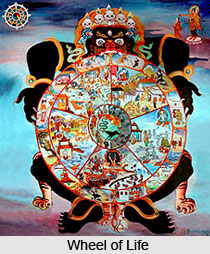 The wheel of life is one of the purest Buddhist emblems. This emblem can be seen in the entrance of almost all monasteries. This emblem is also widely depicted on Thankas or religious scrolls.
The wheel of life is one of the purest Buddhist emblems. This emblem can be seen in the entrance of almost all monasteries. This emblem is also widely depicted on Thankas or religious scrolls.
The circular form of this wheel symbolizes the ceaseless worldly existence. This wheel is held in the clutches of a monster with its claws and teeth and signifies the passionate clinging of the people to exist in this world. The hub of the wheel contains a cock, a snake and a pig as well. The cock signifies lust or desire, the snake signifies anger and the pig symbolizes ignorance and stupidity. These are shown in the centre of the wheel as it is said that they are the root cause of the trouble on earth. In the intermediate circle of the wheel of life, the five worlds are drawn as advised by Lord Buddha. The rim between the intermediate world and the innermost circle of ignorance, lust and envy is drawn in half white and half black. White area symbolizes good deeds and black symbolizes bad or evil deeds. People going upwards in white portion represent people who have performed good deeds in their life time and are now going to take rebirth in the world of gods. People going in the black portion indicate hell or the world of animals.
In the intermediate circle there are five parts that of which the two upper parts symbolize heavenly and human worlds. The remaining three worlds in the lower part symbolize sinful deeds leading to a world of animals, ghosts and hell. Outer most circle shows 12 phases of life.




















